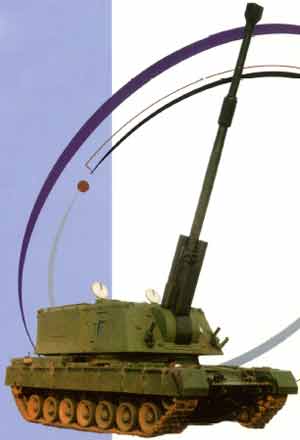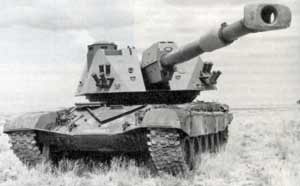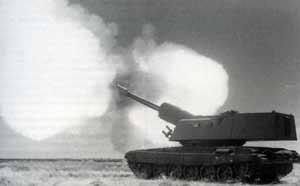| Designation: | T6 |
 |
|---|---|---|
| Manufacturer: | DENEL LAND SYSTEMS, DLS | |
| Product type: | Turrets | |
| Name: | Turret for the self-propelled artillery system |
Designed with Bharat Eath Movers Ltd.
- Integrated C4I
- Automatic ammunition handling
- Automatic gun laying
- Autonomous inertial navigation and gps
- Enhanced bite
- Built in redundancy
The LIW 155 mm 52 calibre turret system has been developed as a private venture by LIW for the export market and builds on the experience obtained in the design, development and production of the 155 mm/ G6/45 calibre 6x6 self-propelled artillery system which is in service with Oman, South Africa and the United Arab Emirates.
The G6, in turn, builds on experience obtained in the combat-proven 155 mm 45 calibre G5 towed artillery system.
The T6 turret can be mounted on any suitable chassis and has already been integrated onto a T-72M1, Arjun and G6 chassis.
The newT6 155 mm 52 calibre turret is a completely autonomous turret system that differs from the G6, in that provision has been made for the storage of projectiles and charges in the turret. This required a repacking of the turret power unit and bustle.
The T6 turret system sent to India was fitted with a 155 mm 52 calibre ordnance which, firing Extended Range Full-Bore Base Bleed (ERFB-BB) projectiles, gives a maximum range of 41,000 m.
The chamber volume is 23 litres, similar to the chamber volume of the standard production 155 mm 45 calibre system. The recoil system has been upgraded and now has diametrically opposed buffers similar to the single buffer used on the G6 but with integral oil replenishers. Two diagrammatically opposed gas-operated recuperators are fitted.
The design of the barrel and cradle has been modified to make it possible to remove and replace the barrel from the front. The barrel is fitted with a double baffle muzzle brake and a steel fume extractor.
The breech mechanism used in the T6 is a newly patented design and is of the slide and swing type with double split rings and obturator pad. An automatic primer loader with a 20 round magazine is integrated with the breech.
A barrel cooling fan is fitted on the cradle to reduce recovery time in the event of unsafe barrel temperatures being reached. A barrel temperature measurement system has also been installed which gives a warning to the commander in case of high barrel temperatures.
The turret is fitted with a fully automated charge and projectile replenishment, handling and loading system.
The T6 turret has been designed to fire all types of NATO ammunition. Using the Denel manufactured ERFB (Extended Range Full Bore) boat tail and Extended Range Full-Bore Base Bleed (ERFB-BB) projectiles, the modular combustible case charge system muzzle velocities and maximum range under standard conditions are as table above:
The ammunition, projectiles, charges and fuzes fired by the more recent T6 are identical to that fired by the well established G5 and G6 155 mm 45 calibre artillery systems.
The charge system is the modular combustile case cartridge system developed bytheSOMCHEM Division of Denel which consists of the M51 charge, M52 charge which can be fitted with one or two charge increments and a stand-alone charge M53 that gives a total of five zones. These charges have special barrel erosion reduction and flash suppression properties.
According to LIW, specifications for dispersion are similar to those of the current production 155 mm 45 calibre system. Probable errors of 0.48 per cent of range and one mile in deflection at 75 per cent of maximum range are quoted.
In firing trials, probable errors of 0.3 to 0.4 per cent of range and 0.35 to 0.4 mile in deflection have been obtainedconsistentlywith both boat tail and base bleed ammunition. Using the M53A2 top charge, barrel life is more than 3,500 rounds.
The T6 system has already been qualified with high-explosive smoke and red phosphorus projectiles, of boat tail and base bleed types, to the full range potential.
The T6 turret has full traverse through 360° with the 155 mm 52 calibre ordnance capable of being elevated from-5to+75°. When travelling the ordnance is held in position by an A-frame which is pivoted at the front of the hull.
The ammunition handling system of the T6 is very flexible and can be changed depending on the tactical situation and the customers exact operational requirements.
The T6 turret carries a total of 40 complete 155 mm rounds and, depending on the chassis type selected, an additional 10 155 mm complete rounds can be carried.
In the ammunition handling system, the projectile and charges are transferred from the carousels to the same position into the charge and projectile loading arms. This facilitates extremely quick loading of all onboard ammunition. Replenishment of the onboard ammunition can be accomplished either through two doors in the turret rear, or via the turret compartment.
The T6 can also fire ammunition directly from a ground pile, so bypassing the ammunition storage system. For this purpose, two openings and trays have been provided in the turret to chassis interface, one on the left side and one on the right side.
Loading is by means of two automatic rammer systems, one for the projectiles and one for the charges.
The maximum rate of fire is 6 rds/min for all onboard ammunition. The sustained rate of fire is 2 rds/min for as long as safe barrel temperatures are maintained as indicated in the temperature warning system.
The T6 uses the same laying and navigation system as used in the G6. An autolaying system is coupled to the laying and navigation system as in the G6 and enables rapid relaying between rounds.
As an independent 36 kW turret power unit is fitted in the turret bustle, the main engine of the chassis can be switched off during firing.
The interface ring between the T6 turret and the T-72 chassis allows for the removal of the T-72 engine with the turret traversed 90° to the side.
The turret is of all-welded steel armour that provides the crew with protection from small arms fire and shell splinters. In total, eight 82 mm smoke grenade launchers are mounted on the front of the turret. An LIW 7.62 mmS77 machine gun is fitted externally on the left cupola for local and anti-aircraft defence.
Standard G6 systems fitted to the T6 are the crew compartment communication system, (intercom and radio) and the automatic fire detection and suppression system. Mounted on the cradle is a muzzle velocity measurement radar.
Early in 1997, the SOMCHEM Division of Denel revealed that it had developed a new 155 mm Velocity enhanced Long-range Artillery Projectile (VLAP) which has a range of more than 50 km.
By 1999, development of the VLAP had been completed and it was moving into the industrialisation phase. The VLAP has been developed for the export market.
As well as being fired from the current 155 mm 45 calibre G5 and G6 artillery systems, VLAP can also be fired from other 155 mm 39 calibre and 52 calibre systems using standard artillery charges.
No modifications are required to the actual weapon for firing the VLAP and there would be no changes to the drills or logistics. Extensive firing trials have shown that the VLAP has excellent reliability, dispersion and range.
The new VLAP has the standard elongated shape with welded nubs which is also used for the ERFB and ERFB-BB projectiles.
In addition to the base bleed unit it also has a rocket motor assist which typically extends the range by 10 km depending on the weapon and charge used.
As the rocket motor extends into the VLAP body there is some loss of HE content when compared with the standard ERFB projectiles.
SOMCHEM stresses that the VLAP is complementary to Denel's existing 155 mm ERFB and ERFB-BB projectiles as it would enable friendly artillery systems to engage threat artillery systems while remaining safe from counter battery fire.
In addition, it would enable targets well to the rear such as command centres, air defence systems and logistics centres, which are now beyond the range of many artillery systems, to be engaged.
Status
Development complete. Ready for production. Evaluated in India.
|
||||||||||||||||||||||||
|
|||||||||
|
|||||||||
 |
 |
 |